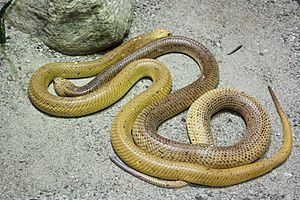Cape Cobra facts for kids
Quick facts for kids Cape Cobra |
|
|---|---|
 |
|
| Scientific classification | |
| Kingdom: | |
| Phylum: | |
| Class: | |
| Order: | |
| Suborder: | |
| Family: | |
| Genus: | |
| Species: |
N. nivea
|
| Binomial name | |
| Naja nivea (Linnaeus, 1758)
|
|
| Synonyms | |
|
Naja flava Merrem |
|
The Cape cobra (Naja nivea), also known as the yellow cobra, is a very venomous snake. It lives in many different natural areas across southern Africa. These areas include dry savannas, fynbos (a type of shrubland), bushveld, and deserts.
This snake is active during the day. It hunts many different animals and also eats dead animals. Birds like eagles, honey badgers, and mongooses are some of its predators. In South Africa, people also call the Cape cobra "geelslang" (yellow snake) and "bruinkapel" (brown cobra). Sometimes, it's even called "koperkapel" (copper cobra) because of its bright yellow color. There are no known subspecies of the Cape cobra.
Contents
What Does the Cape Cobra Look Like?
The Cape cobra is a medium-sized snake. Adult snakes are usually about 1.2 to 1.4 metres (3.9 to 4.6 ft) long. Some can grow up to 1.6 metres (5.2 ft). Males are a little bigger than females. The longest Cape cobra ever recorded was a male from Aus, Namibia. It measured 1.88 metres (6.2 ft) long!
Cape cobras come in many different colors. They can be yellow, golden brown, dark brown, or even black. Some snakes also have black or pale spots and blotches. While colors often depend on where the snake lives, you can find almost all color types in one place. For example, cobras in the Kalahari Desert are usually yellow. But in places like De Hoop Nature Reserve, you can see all the different colors.
Young Cape cobras have dark throats. This dark color goes down their belly for a short distance. This can sometimes make people confuse them with the Rinkhals snake. But this dark color usually fades as the young cobra gets older.
How Do Cape Cobras Behave?
Cape cobras are active during the day. They hunt for food throughout the daylight hours. If it's very hot, they might hunt during dawn or dusk instead. They mostly stay on the ground. However, they are good at climbing trees and bushes. They are known for raiding the nests of sociable weaver birds.
When not hunting, they hide in holes or under piles of brush. They often stay in the same hiding spot for a while. Cape cobras are fast and alert snakes. If they feel threatened, they will strike quickly. When they are scared, they lift the front part of their body. They also spread a wide hood and might hiss loudly. If you stay still, the snake will try to escape. But if you move, it will go back to its defensive pose. Cape cobras can be more aggressive when they are mating.
What Do Cape Cobras Eat?
Cape cobras eat many different things. They are not picky eaters! Their diet includes other snakes, small animals like rodents, lizards, and birds. They also eat dead animals.
A study at De Hoop Nature Reserve showed what Cape cobras ate. About 31% of their diet was rodents. Other snakes made up 20% of their meals. Lizards and birds each made up 11%. Dead animals were 16% of their diet. They even sometimes eat other Cape cobras (11%). The study also saw Cape cobras eating dead snakes on the road. They are famous for raiding the nests of sociable weaver birds.
Cape Cobra Venom
The Cape cobra is one of the most dangerous snakes in Africa. This is because its venom is very strong. It also often lives near people's homes. The venom of this snake is thick and sticky. When it dries, it looks like shiny, pale flakes, similar to yellow sugar.
The Cape cobra's venom contains powerful neurotoxins. These toxins affect the respiratory system (how you breathe) and the nervous system. The venom might also contain cardiotoxins, which affect the heart.
If a person is bitten, the effects can be very serious. The amount of venom injected can vary. Death can happen in as little as an hour in severe cases. It can also take ten hours or more. Death is often caused by breathing failure because the venom causes paralysis.
If someone is bitten, they often need help breathing with a machine. They also need other medical care to manage their symptoms. For serious bites, antivenom is needed. The antivenom used is made by the South African Institute of Medical Research (SAIMR).
Images for kids
-
A Cape cobra eating in a nest of Sociable weavers.
See also
 In Spanish: Cobra del Cabo para niños
In Spanish: Cobra del Cabo para niños



